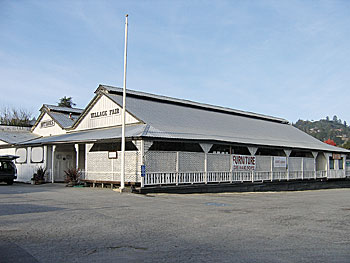By Kevin Newhouse

In early 1881, Frederick Augustus (F.A.) Hihn, a German immigrant who came to California in 1849 (and eventually Santa Cruz in 1851), purchased 27-acres of land in today’s Aptos Village in anticipation of opening his lumber operation in the Valencia Creek watershed. He used part of the property as a lumberyard and leased some of it to a local farmer to grow hay.
At the turn of the 20th century, the logging industry slowed down dramatically. Hihn was already planning for the transition into the next industry, which would be apples. He started paying the unemployed lumberjacks to plant apple orchards on his land. Eventually, Hihn would sell these orchards to the same lumberjacks who planted them. Hihn was not only a smart man … he was a generous man. He would allow the men to pay off their land over 10 years and if they passed away before the land was paid off, the title was transfer to his wife free and clear.
Hihn constructed the barn that houses Village Fair Antiques today sometime between 1890 and 1891. It was most likely used as a hay barn originally. It later served as an apple-packing barn that would store, process, and package the apples before they were shipped by rail.
As you can see, Hihn was involved in all steps along the way. He sold the land that grew the apples that were packed in his barn which were then shipped on his rail lines. Not a bad business model if you ask me!
Hihn died in 1913 and the packinghouse switched hands a number of times over the next few decades until February 1944, when Fred Toney and his wife Elma (who went by the moniker of “Babe”) purchased The Bay View Hotel from the Arano family. The Toneys also purchased the surrounding property, which included the apple barn.
Fred was a local businessman who was responsible for moving the Bay View Hotel 100 feet west of its original location to the its present spot in the village. Babe had begun her antique and gift shop business from inside the hotel. After some success, she had decided to move it to the barn with hopes that other merchants would share the space.
In July 1965, Fred took the old apple-packing barn behind the hotel, divided the interior into booths, gave it the name “Village Fair” and put up a sign advertising space to lease. By February 1966, Village Fair housed 10 antique dealers, a produce department, hardware, nursery, art booth, coins, a weaving concession, general bric-a-brac, and a smoked meat stand. Toney had plans to build a different roofline for each individual booth, giving the illusion of a miniature village of the early 1900s. The concessionaires participated by wearing outfits of that period each Sunday.
On June 12, 1979, Fred and Babe were returning home after delivering antiques to a customer when they were involved in a terrible car accident. The Toneys were heading north on Interstate 5 when they lost control of their truck and ended up flipping the vehicle. Both Fred, who was driving, and his wife were ejected from the truck. They were taken to Fresno’s Valley Medical Center where Fred subsequently died. His wife, Babe, was listed in critical condition and survived a week before succumbing to her injuries on June 19.
Fred and Babe were survived by their daughters Patricia and Gail who retained ownership of Village Fair until February 2007 when Barry Swenson Builders purchased the property. Swenson plans on adding a new foundation to the building, relocating it to a new spot in Aptos Village, and leasing it to New Leaf Community Markets.
•••
For more information about the Aptos History Museum, upcoming events, or becoming a member of the museum, please visit www.aptoshistory.org and follow us on Instagram@aptos_history_museum.